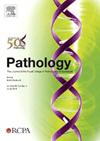Beyond nest size: the clinicopathological spectrum of large nested melanocytic tumours and the value of comparative genomic hybridisation and messenger RNA expression analysis
IF 3.6
3区 医学
Q1 PATHOLOGY
引用次数: 0
Abstract
Large nested melanomas (LNMs) are a rare subtype of naevoid melanoma consisting of large junctional melanocytic nests that are more common in older individuals and/or associated with sun damage. However, the presence of large melanocytic nests alone does not lead to a diagnosis of malignancy, as they can also be found in melanocytic naevi. LNMs are challenging because they lack most classic histological features of malignancy and require thorough clinicopathological evaluation. This ambiguity calls for a critical reassessment of the current diagnostic criteria for the subclassification of benign or malignant within the spectrum of large nested melanocytic tumours (LNMTs). Eighteen LNMTs and six special-site melanocytic naevi (SSMNs) were studied using different approaches: clinical features, dermoscopy, histopathology, immunohistochemistry, array comparative genomic hybridisation (aCGH) and messenger RNA (mRNA) sequencing analysis, with the aim of identifying novel and reproducible criteria for the recognition of LNMs.Careful clinicopathological evaluation of the 18 LNMTs led to the diagnosis of seven LNMs and 11 large nested melanocytic naevi (LNMNs). Lentiginous spread and nest bridging were significantly associated with LNMs after Holm–Bonferroni correction. Asymmetry, largest nest size, poor lateral demarcation, the number of colours and dermoscopic structures, and preferentially expressed antigen in melanoma (PRAME) immunostaining were more common in LNMs but did not reach statistical significance. Four of seven LNMs and nine of 11 LNMNs lacked the BRAF V600E mutation. Regarding aCGH, no LNMN or SSMN cases had ≥3 copy number variations (CNVs), in contrast to 50% of LNM cases. Importantly, LNM and LNMN could be distinguished by differential mRNA expression of nine genes. Our study demonstrates that there is a spectrum of LNMTs and that the clinicopathological diagnosis of LNM, for which we support the term ‘late-onset nested naevoid melanomas’, can be significantly strengthened by the presence of lentiginous pattern, nest bridging, gene CNV and differential mRNA expression.
超越巢大小:大型巢状黑素细胞瘤的临床病理学谱系以及比较基因组杂交和信使 RNA 表达分析的价值。
大黑素细胞巢黑色素瘤(LNMs)是一种罕见的黑素细胞痣亚型,由交界性大黑素细胞巢组成,多见于老年人和/或与日光损伤有关。然而,仅仅出现大的黑色素细胞巢并不能诊断为恶性肿瘤,因为黑色素细胞痣中也可能出现大的黑色素细胞巢。LNMs具有挑战性,因为它们缺乏大多数恶性肿瘤的典型组织学特征,需要进行全面的临床病理学评估。这种模糊性要求对目前的诊断标准进行严格的重新评估,以便在大型巢状黑素细胞瘤(LNMTs)的范围内进行良性或恶性的亚分类。研究人员采用临床特征、皮肤镜检查、组织病理学、免疫组织化学、阵列比较基因组杂交(aCGH)和信使核糖核酸(mRNA)测序分析等不同方法,对18种LNMT和6种特殊部位黑素细胞痣(SSMN)进行了研究,目的是找出识别LNM的新颖且可重复的标准。对18个LNMT进行仔细的临床病理学评估后,诊断出7个LNM和11个大的巢状黑素细胞痣(LNMN)。经Holm-Bonferroni校正后,皮损扩散和巢桥与LNM明显相关。不对称、最大的巢大小、侧面分界不清、颜色和皮肤镜结构的数量以及黑色素瘤中优先表达的抗原(PRAME)免疫染色在 LNMs 中更为常见,但未达到统计学意义。7 个 LNMs 中有 4 个缺乏 BRAF V600E 突变,11 个 LNMNs 中有 9 个缺乏 BRAF V600E 突变。在 aCGH 方面,没有 LNMN 或 SSMN 病例有≥3 个拷贝数变异(CNV),而 LNM 病例中有 50%的拷贝数变异。重要的是,LNM 和 LNMN 可通过 9 个基因的不同 mRNA 表达加以区分。我们的研究表明,LNMTs 有一个谱系,而 LNM(我们支持将其称为 "晚发型巢状黑素瘤")的临床病理诊断,可以通过皮损形态、巢桥接、基因 CNV 和差异 mRNA 表达的存在得到显著加强。
本文章由计算机程序翻译,如有差异,请以英文原文为准。
求助全文
约1分钟内获得全文
求助全文
来源期刊

Pathology
医学-病理学
CiteScore
6.50
自引率
2.20%
发文量
459
审稿时长
54 days
期刊介绍:
Published by Elsevier from 2016
Pathology is the official journal of the Royal College of Pathologists of Australasia (RCPA). It is committed to publishing peer-reviewed, original articles related to the science of pathology in its broadest sense, including anatomical pathology, chemical pathology and biochemistry, cytopathology, experimental pathology, forensic pathology and morbid anatomy, genetics, haematology, immunology and immunopathology, microbiology and molecular pathology.
 求助内容:
求助内容: 应助结果提醒方式:
应助结果提醒方式:


